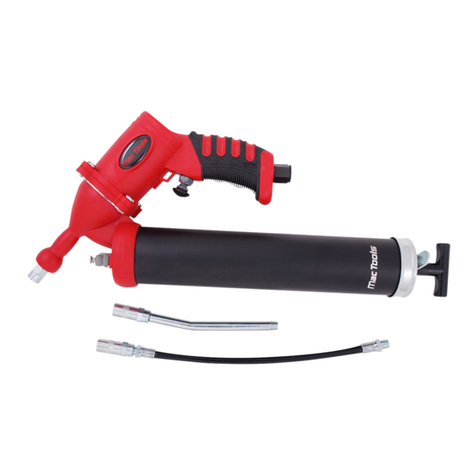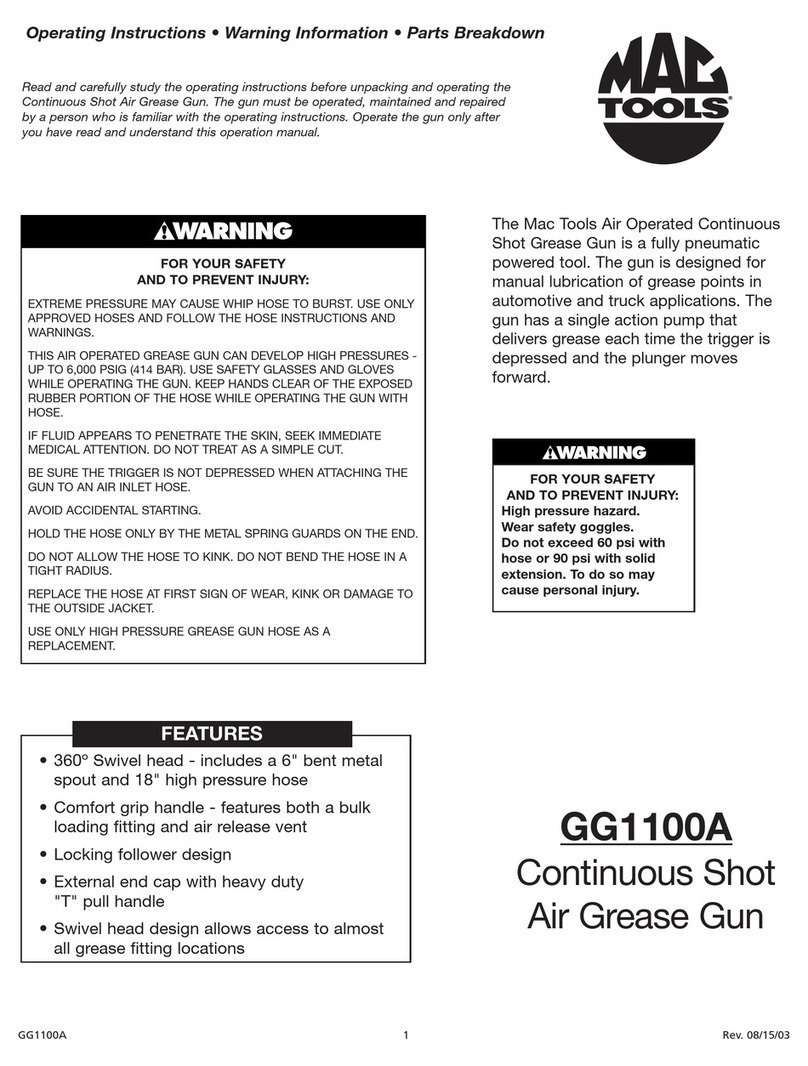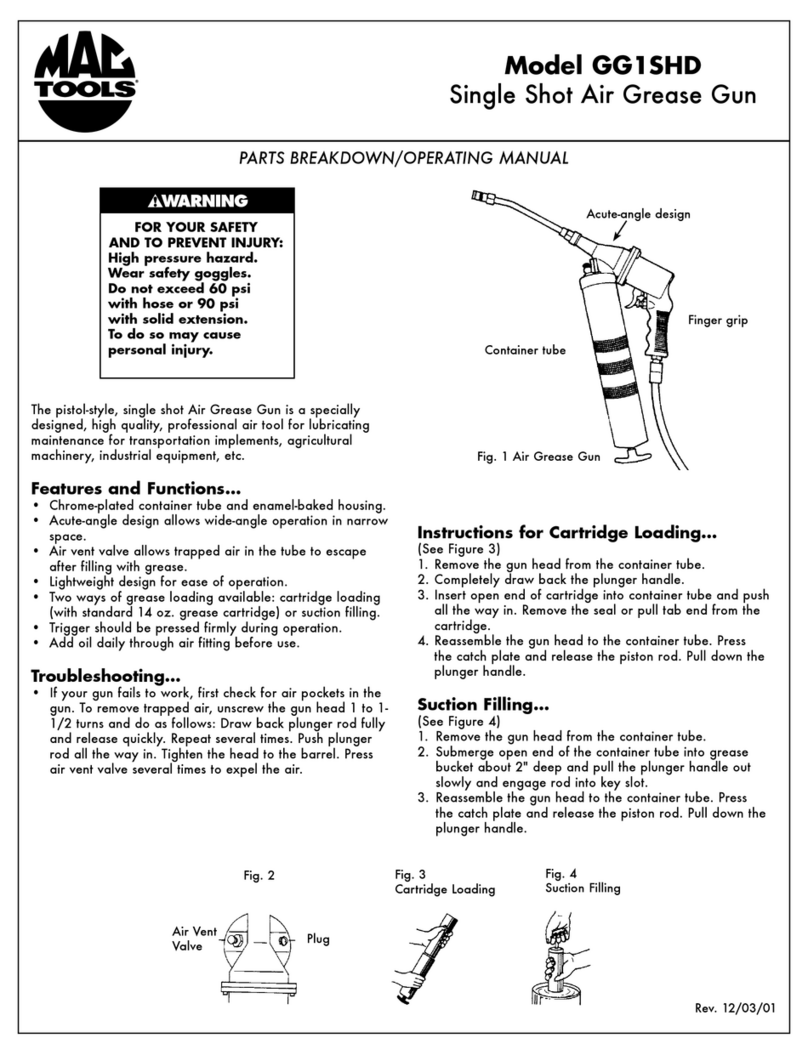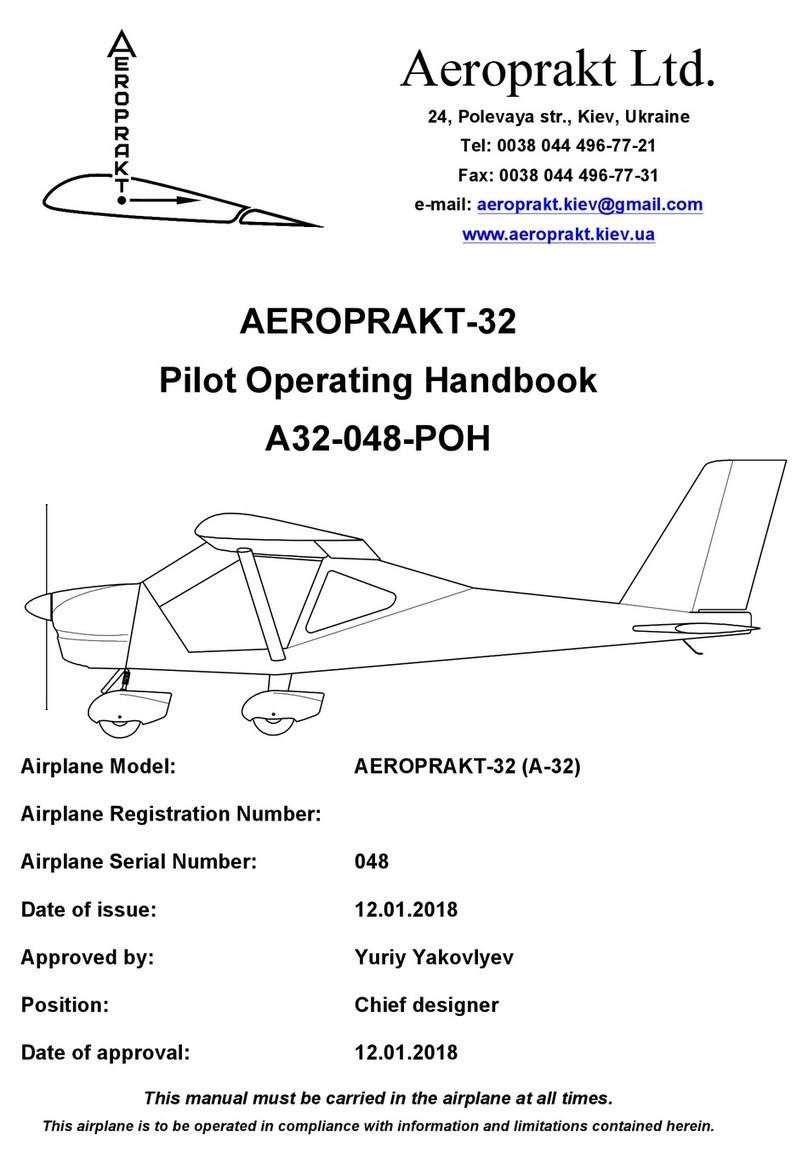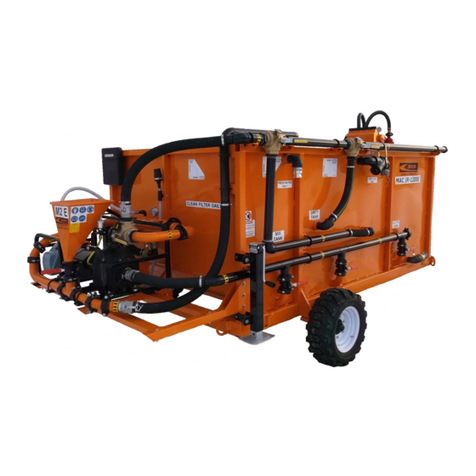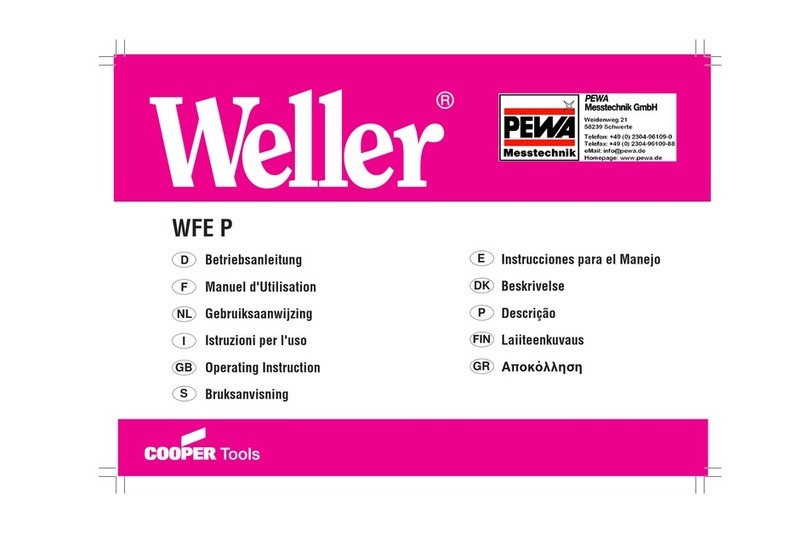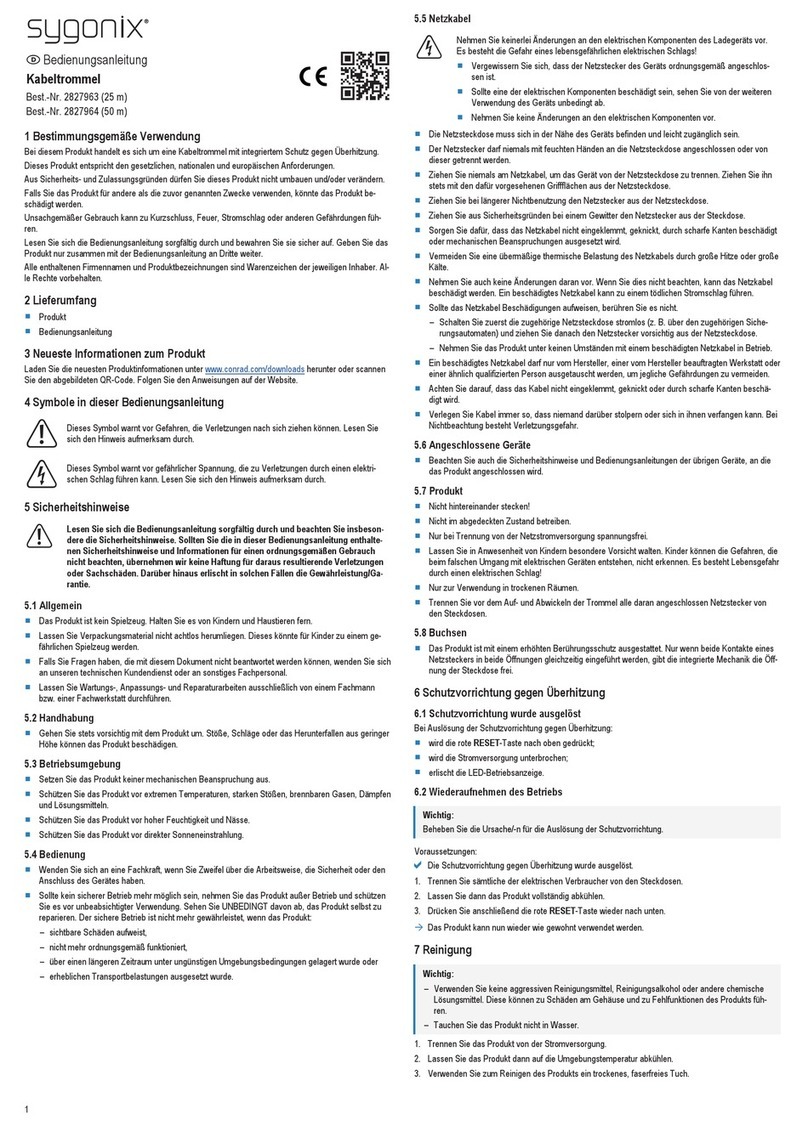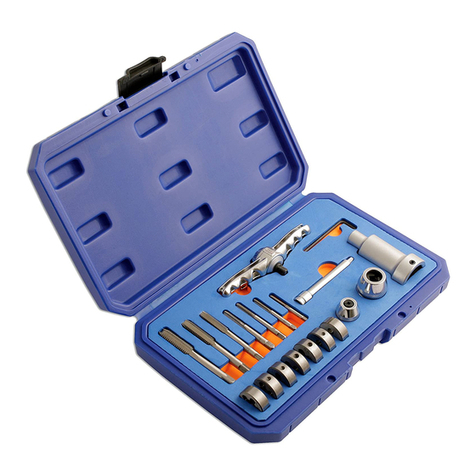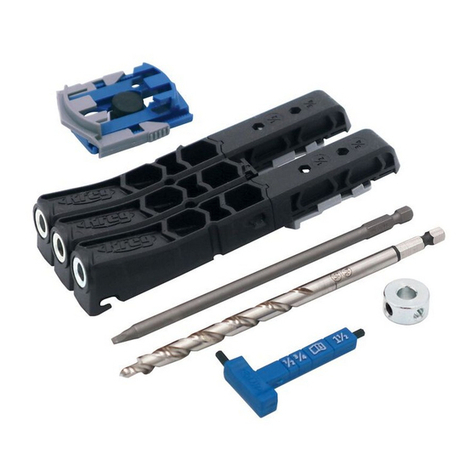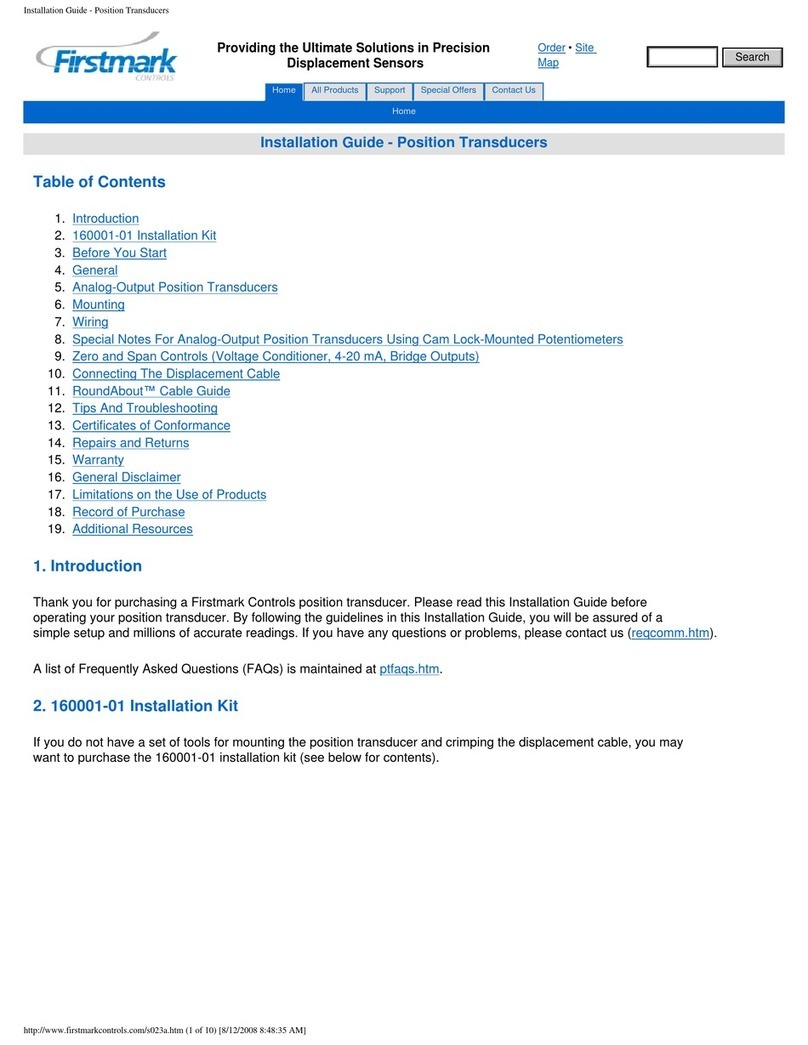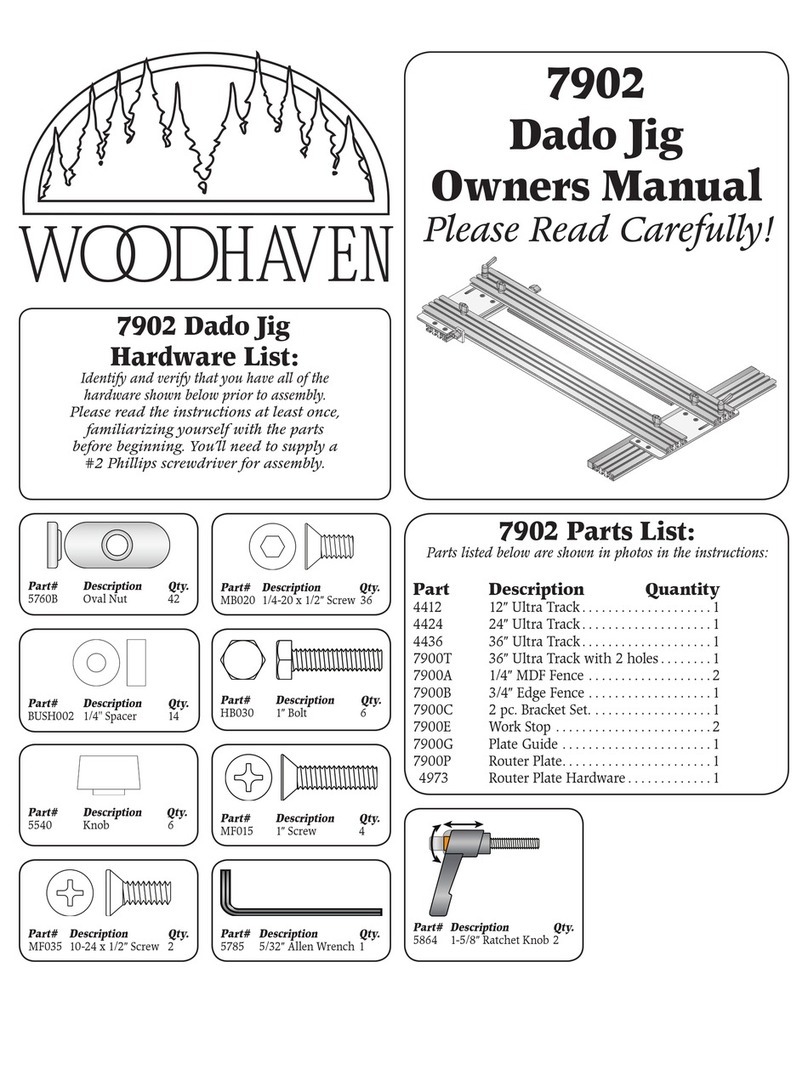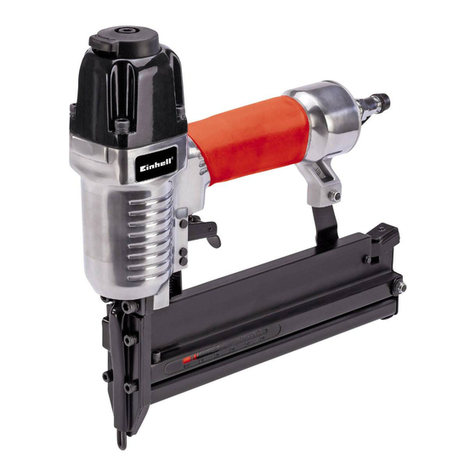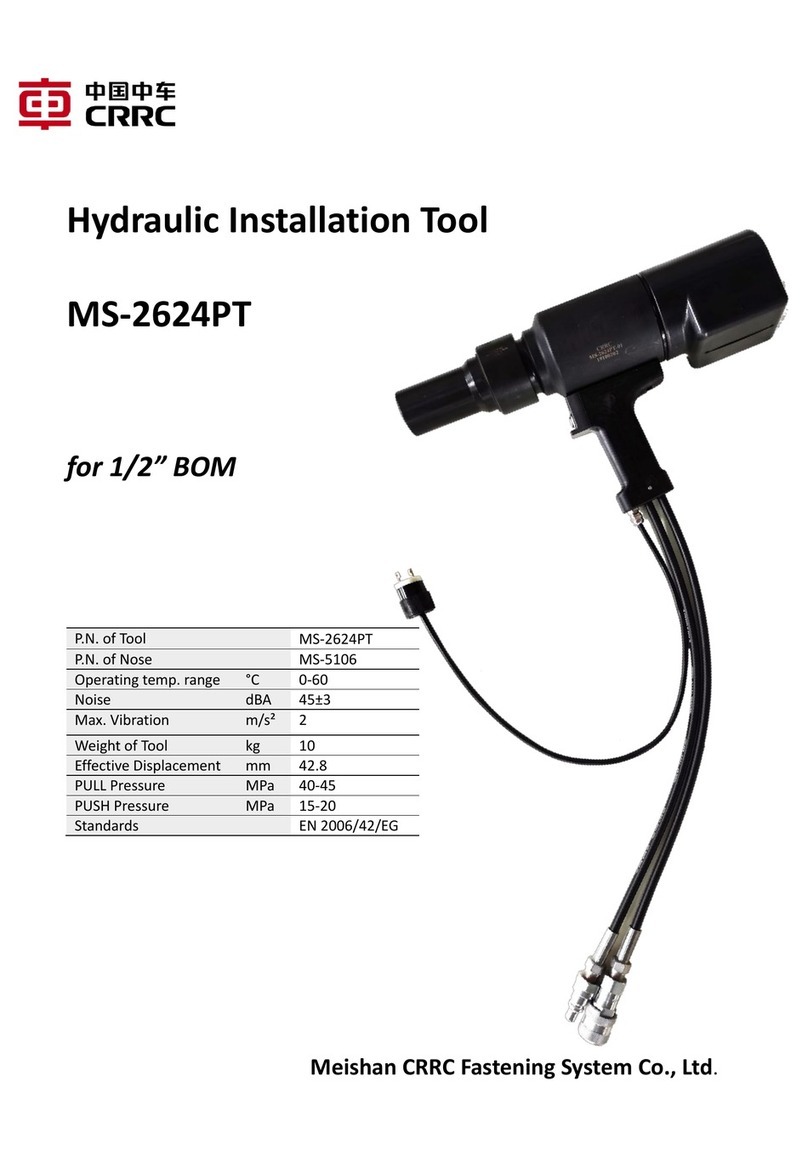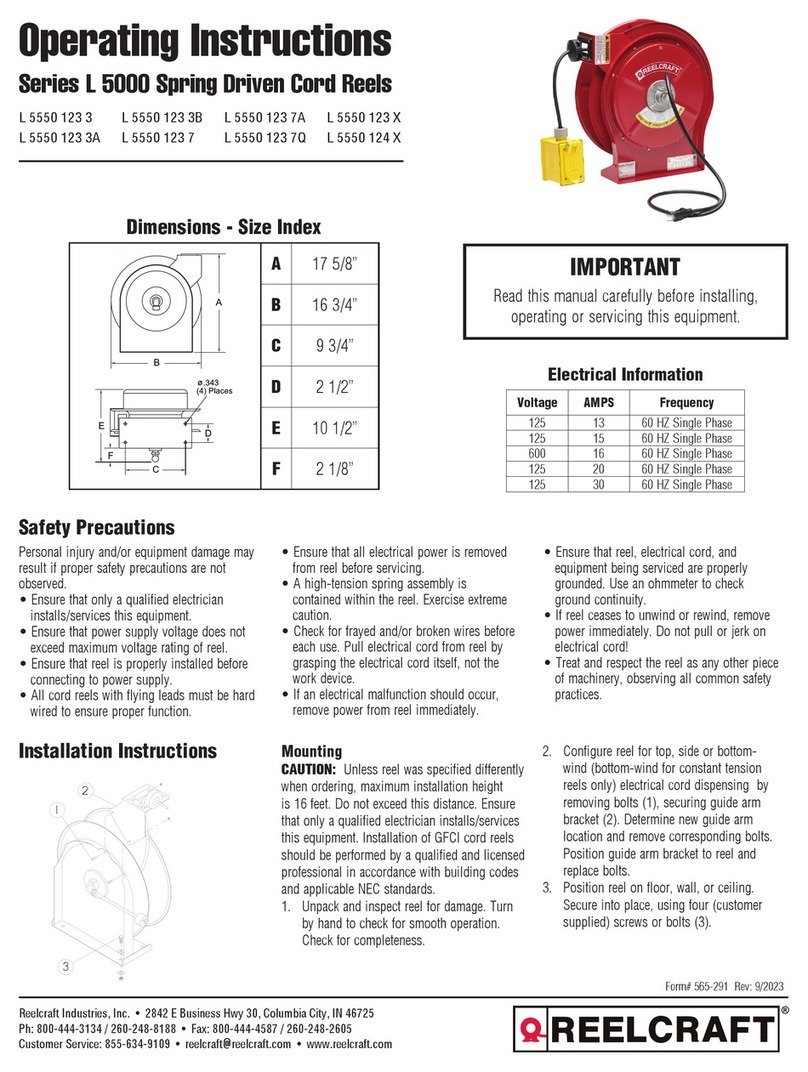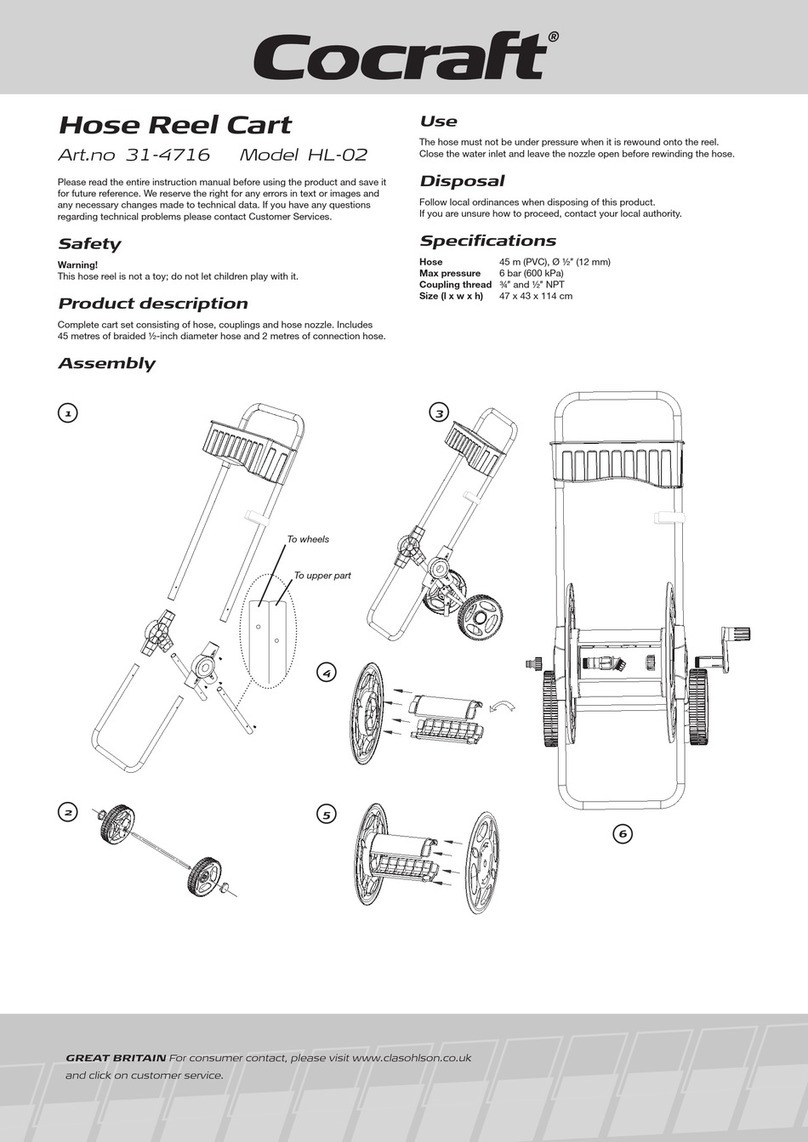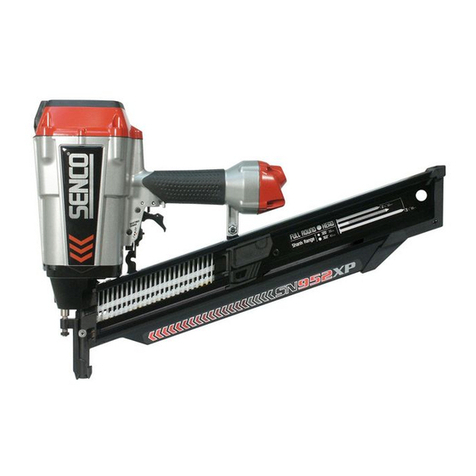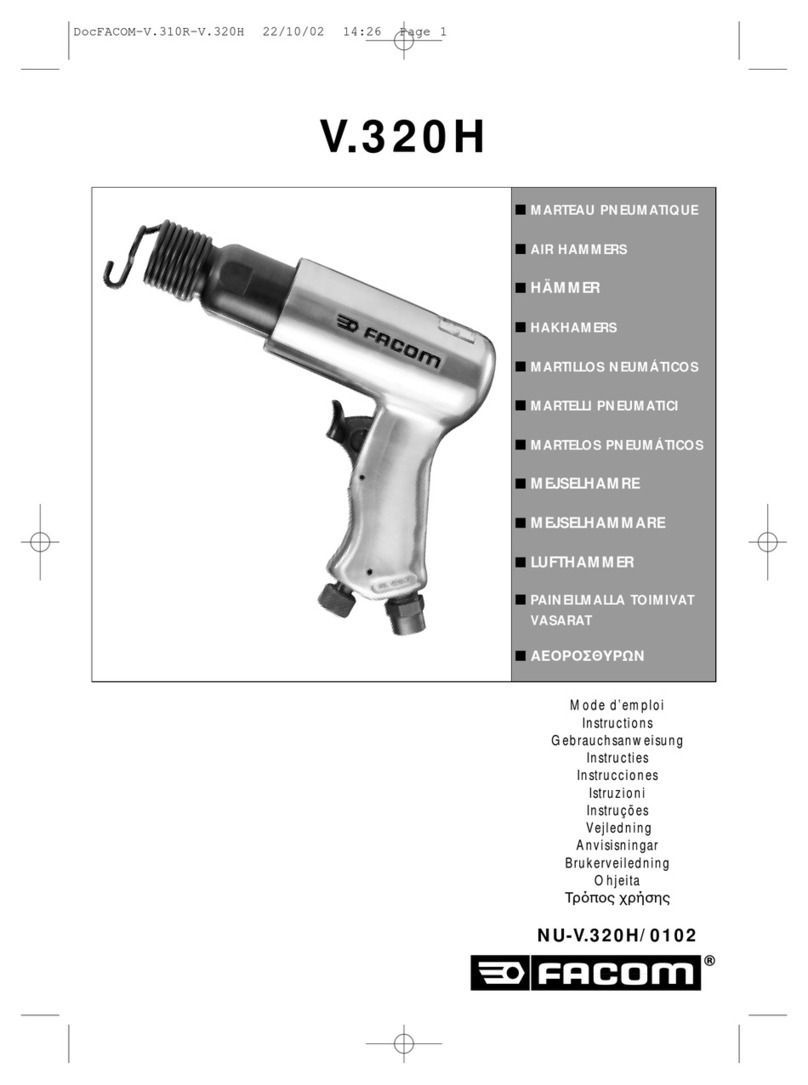MAC TOOLS MPH1931 User manual

Long Barrel .401" Shank Air Hammer
Short Barrel .401" Shank Air Hammer
MPH1911
MPH1931
Operation and
Maintenance Manual
© 2017 Mac Tools
To reduce the risk of injury, read and
understand these safety warnings and
instructions before using the tool.
Keep these instructions with the tool
for future reference. If you have any
questions, contact your MAC TOOLS
representative or distributor.
WARNING

MACTOOLS.COM
2
TABLE OF CONTENTS
Introduction 3
Safety Instructions 3 - 7
Maintenance 7
Chisel Assembly 8
Specifications 9
Tool Components 10 - 11
Contact Information 12
WARNING
IMPORTANT SAFETY INFORMATION ENCLOSED.
READ THIS MANUAL BEFORE OPERATING THE TOOL.
SAVE FOR FUTURE REFERENCE
FAILURE TO OBSERVE THE FOLLOWING WARNINGS COULD RESULT IN INJURY.
6.2 bars
(90 psig/
620 kPa)
6.2 bars
(90 psig/
620 kPa)
6.2 bars
(90 psig/
620 kPa)
6.2 bars
(90 psig/
620 kPa)
6.2 bars
(90 psig/
620 kPa)
Do not use damaged, frayed or
deteriorated air hoses and fittings.
Air powered tools can vibrate in
use. Vibration, repetitive motions or
uncomfortable positions may be harmful
to your hands and arms. Stop using any
tool if discomfort, tingling feeling or
pain occurs. Seek medical advice before
resuming use.
Do not carry the tool by the hose.
Keep body stance balanced and firm. Do
not overreach when operating this tool.
Do not use tool under the influence of
drugs, alcohol, medication, or if you are
tired.
Always turn off the air supply and
disconnect the air supply hose before
installing, removing or adjusting
any accessory on this tool, or before
performing any maintenance on this tool.
Use protective equipment such as
glasses, gloves, safety shoes, as well
as acoustic protection.
Remain vigilant, use common sense
and pay attention when using the
tool.
Always wear ANSI Z87.1 CAN CSA
Z94.3 eye protection or for Europe,
suitable CE marked eye protection
when operating or performing
maintenance on this tool.
Always wear suitable respiratory
protection when operating this tool.
Operate at 90 psig (6.2 bar / 620
kPa) Maximum air pressure.
Do not over-oil and do not use
heavy grade oil as stalling and low
performance may result.
6.2 bars
(90 psig/
620 kPa)
6.2 bars
(90 psig/
620 kPa)
6.2 bars
(90 psig/
620 kPa)
6.2 bars
(90 psig/
620 kPa)
6.2 bars
(90 psig/
620 kPa)

800.MACTOOLS
3
INTRODUCTION
The
Mac Tools™MPH1911 and MPH1931 Air Hammers
are precision-built tools, designed for professionals for
separating ball joints and tie rod ends, breaking free seized parts, cutting body panels and tail pipes, as well as
chipping, riveting, and scaling, etc. These tools will deliver efficient, dependable service when used correctly
and with care. As with any fine power tool, for best performance the manufacturer’s instructions must be fol-
lowed. Please study this manual before operating the tool and understand the safety warnings and instructions.
The instructions on installation, operation and maintenance should be read carefully, and the manual kept for
reference. NOTE: Additional safety measures may be required because of your particular application of the tool.
Contact your
Mac Tools
representative or distributor with any questions concerning the tool and its use.
MACTOOLS.COM
Mac Tools
•
505 North Cleveland Avenue
•
Westerville, Ohio 43082 800.MACTOOLS
Mac Tools-Europe, Stanley Black & Decker Inc.
•
Unit 3, Europa Court
Sheffield Business Park
•
Sheffield, S9 1XE
0114 2917266
GENERAL SAFETY INSTRUCTIONS
WARNING
WARNING! Read all safety warnings and all instructions. Failure to follow the warning and instructions may
result in electric shock, fire and or serious injury.
Wear personal protective equipment. Depending on application, use face shield,
safety goggles or safety glasses. As appropriate, wear dust mask, hearing protectors, gloves and
workshop apron capable of stopping small abrasive or workpiece fragments.
The eye protection must be capable of stopping flying debris generated by various operations. The dust mask
or respirator must be capable of filtrating particles generated by your operation. Prolonged exposure to high
intensity noise may cause hearing loss. Everyday eyeglasses are NOT safety glasses. Also use face or dust mask
if cutting operation is dusty. ALWAYS WEAR CERTIFIED SAFETY EQUIPMENT:
• ANSI Z87.1 eye protection (CAN/CSA Z94.3)
• ANSI S12.6 (S3.19) hearing protection
• NIOSH/OSHA/MSHA respiratory protection
1) WORK AREA SAFETY
• Keep work area clean and well lit. Cluttered or dark areas invite accidents.
• Do not operate power tools in explosive atmospheres, such as in the presence of flammable liquids, gases
or dust. Power tools create sparks which may ignite the dust or fumes.
• Do not use in wet conditions.
• Keep children and bystanders away while operating a power tool. Distractions can cause you to lose
control.
2) PERSONAL SAFETY
• Stay alert, watch what you are doing and use common sense when operating a power tool. Do not use a
power tool while you are tired or under the influence of drugs, alcohol or medication. A moment of
inattention while operating power tools may result in serious personal injury.
• Prevent unintentional starting. Ensure the trigger is in the off position before connecting to air source, pic-
king up or carrying the tool. Carrying power tools with your finger on the switch or energizing power tools
that have the switch on invites accidents.
• Exposure to high noise levels can cause permanent, disabling hearing loss and other problems, such as
tinnitus (ringing, buzzing, whistling, or humming in the ears). Therefore, a risk assessment and the imple-
mentation of appropriate controls for these hazards are essential. Appropriate controls to reduce the risk
may include actions such as damping materials to prevent workpieces from ringing.
• Dress properly. Do not wear loose clothing or jewelry. Keep your hair, clothing and gloves away from

MACTOOLS.COM
4
moving parts. Loose clothes, jewelry or long hair can be caught in moving parts.
• Keep hands and other body parts, loose clothing and long hair away from the moving end of tool.
• Anticipate and be alert for sudden changes in motion during start up and operation of any power tool.
• Operators and maintenance personnel must be physically able to handle the bulk, mass and power of the
tool.
• Keep body stance balanced and firm. Do not overreach when operating this tool.
• Do not operate this tool for long periods of time. Vibration caused by tool action may be harmful to your
hands and arms. Stop using any tool if discomfort, tingling feeling or pain occurs. Seek medical advice
before resuming use.
•
Do not cut into areas which may contain electrical wiring or piping.
This tool is not insulated against elec-
tric shock, contact with a live wire will make exposed metal parts live.
• For USA: Some dust created by power sanding, sawing, grinding, drilling, chipping and other construction
activities contains chemicals known to the State of California to cause cancer, birth defects or other repro-
ductive harm. Some examples of these chemicals are:
- lead from lead-based paints,
- crystalline silica from bricks and cement and other masonry products, and
- arsenic and chromium from chemically-treated lumber.
Your risk from these exposures varies, depending on how often you do this type of work. To reduce your
exposure to these chemicals: work in a well ventilated area, and work with approved safety equipment,
such as those dust masks that are specially designed to filter out microscopic particles.
• Accessories and tools can get hot during operation. Wear gloves when touching them.
• Keep bystanders a safe distance away from work area. Anyone entering the work area must wear personal
protective equipment. Fragments of workpiece or of a broken accessory may fly away and cause injury
beyond immediate area of operation.
• Never direct air at yourself or anyone else.
• Wear warm clothing whenever working in cold conditions and keep your hands warm and dry.
• Whipping hoses can cause severe injury. Always check for damaged or loose hoses and fittings.
• Avoid prolonged contact with dust from power sanding, sawing, grinding, drilling, chipping and other
construction activities. Wear protective clothing and wash exposed areas with soap and water. Allowing
dust to get into your mouth, eyes, or lay on the skin may promote absorption of harmful chemicals.
• Use of this tool can generate and/or disperse dust, which may cause serious and permanent respiratory
or other injury. Always use NIOSH/OSHA suitable approved respiratory protection appropriate for the dust
exposure and suitable extraction systems. Direct particles away from face and body.
• Store idle power tools out of the reach of children and do not allow persons unfamiliar with the power tool
or these instructions to operate the power tool. Power tools are dangerous in the hands of untrained users.
• This product may contain one or more chemicals known to the State of California to cause cancer and
birth defects or other reproductive harm. Wash hands thoroughly after handling.
• Do not let children come in contact with this tool. Supervision is required when inexperienced operators
use this tool.
• Do not modify this tool. Modifications can reduce the effectiveness of safety measures and increase the
risks to the operator.
• Do not discard the safety instructions; give them to the operator.
• Do not use the tool if it has been damaged.
• Be aware that the failure of the workpiece or accessories, or even of the tool itself, can generate high-velo-
city projectiles.
• This product is not intended for use by persons (including children) suffering from diminished physical,
sensory or mental abilities; lack of experience, knowledge or skills unless they are supervised by person
responsible for their safety. Children should never be left alone whith this product. This tool and its acces-
sories must be used in compliance with these instructions. Using it for any other purpose may cause a risk
of danger for people and the environment.
• Only qualified and trained operators should install, adjust or use the tool.
• For overhead work, wear a safety helmet.
• Sparks from cutting can ignite clothing and cause severe burns. Ensure sparks do not land on clothing.

800.MACTOOLS
5
Wear fire-retardant clothing and have a bucket of water nearby.
• Direct the exhaust so as to minimize disturbance of dust in a dust-filled environment.
• Where dust or fumes are created, the priority shall be to control them at the point of emission.
• All integral features or accessories for the collection, extraction or suppression of airborne dust or fumes
should be correctly used and maintained in accordance with the manufacturer’s instructions.
• Select, maintain and replace the consumable/inserted tool as recommended in the instructions, to prevent
an unnecessary increase in dust or fumes.
• Always operate, inspect and maintain this tool in accordance with American National Standards Institute
Safety Code for Portable Air Tools (ANSI B186.1) and any other applicable safety codes and regulations.
3) POWER TOOL USE AND CARE
• Before running the tool, check that there is no dangerous interaction with the immediate environment
(explosive gas, flammable or dangerous liquid, unknown piping, electric sheathing or cable, etc).
• Before connecting the tool to the air inlet, check the trigger is not blocked in the on position by an obs-
tacle.
• In the event of blockage, release the trigger and disconnect the tool from the compressed air network.
• Ensure that the unit on which work is being carried out is immobilized.
• Always operate, inspect and maintain this tool in accordance with all regulations (local, state, federal and
country), that may apply to hand held/hand operated pneumatic tool.
• For safety, top performance, and maximum durability of parts, operate this tool at 90 psig.
(6.2 bar / 620 kPa) maximum air pressure at the inlet with 3/8’’ (10mm) inside diameter air supply hose.
• Always use clean, dry air. Dust, corrosive fumes and/or excessive moisture can ruin the motor of an air
tool.
• Exceeding the maximum pressure of 90 psig (6.2 bar / 620 kPa) will lead to the risk of danger such as
excessive speed, tool wear, breaking parts, higher torque or force that may destroy the tool and its acces-
sories or the part being worked on.
• Maintain power tools. Check for misalignment or binding of moving parts, breakage of parts and any other
condition that may affect the power tool’s operation. If damaged, have the power tool repaired before use.
Many accidents are caused by poorly maintained power tools.
• Keep cutting tools sharp and clean. Properly maintained cutting tools with sharp cutting edges are less
likely to bind and are easier to control.
• Use rated accessories recommended by Mac Tools only. Inspect accessories before use. Do not use crac-
ked or damaged accessories. Just because the accessory can be attached to your power tool, it does not
assure safe operation.
• Use the power tool, accessories and tool bits, etc. in accordance with these instructions, taking into ac-
count the working conditions and the work to be performed. Use of the power tool for operations different
from those intended could result in a hazardous situation.
•
For multiple hazards, read and understand the safety instructions before installing, operating, repairing, main-
taining, changing accessories on, or working near the saw. Failure to do so can result in serious bodily injury.
• Ensure that sparks and debris resulting from use do not create a hazard.
• The pneumatic tool must be fitted and connected to the compressed air network via quick disconnects to
facilitate shutdown in the event of danger.
• When the life of the tool has expired, it is recommended that the tool be disassembled, degreased and
parts be separated by material so that they can be recycled.
• Always turn off the air supply and disconnect the air supply hose before installing, removing or adjusting
any accessory on this tool, or before performing any maintenance on this tool.
• Do not use damaged, frayed or deteriorated air hoses and fittings. Do not abuse hoses or connectors.
• Do not lubricate tools with flammable or volatile liquids such as kerosene, diesel or jet fuel.
• Do not remove any labels. Replace any damaged label.
• Do not use the tool if the trigger does not turn the tool on or off.
• Do not lock, tape or wire the "on/off" safety lever in the "on" position, as the lever must be free to return to
the "off" position when released.
• Be sure all hoses and fittings are the correct size and are tightly secured.

MACTOOLS.COM
6
• The use of a hose whip is recommended. A coupler connected directly to the air inlet increases tool bulk
and decreases tool maneuverability.
• For maximum performance, the coupler on the wall should be the next size larger than the coupler used on
the tool. The coupler closest to the tool should not be less than the proper air supply hose size.
• Use clamps or another practical way to secure and support the workpiece to a stable platform. Holding the
work by hand or against the body is unstable and can lead to loss of control.
• When not in use, disconnect tool from air supply to prevent accidental or unauthorized use in the absence
of the operator.
• Do not alter any part/component/accessory of this tool in any way.
• Mesh air strainer at air inlet occasionally becomes clogged with debris, blocking air supply, and decreasing
the tool's performance. If this occurs the mesh air strainer needs to to be cleaned.
• Store idle power tools out of the reach of children and do not allow persons unfamiliar with the power tool
or these instructions to operate the power tool. Power tools are dangerous in the hands of untrained users.
• Place the tool on the work surface before starting the tool. Do not point or indulge in any horseplay with
this tool.
• When cutting off, the workpiece shall be supported such that the slot is kept at constant or increasing
width during the complete operation.
• If the bit becomes jammed in a cut slot, shut off the hammer and ease the bit free. Check that the bit is
still correctly secured and not damaged before continuing the operation.
4) SERVICE
• Tool service must be performed by qualified repair personnel, using only Mac Tools authorized, identical
replacement parts. Use only lubricants recommended by Mac Tools.
ADDITIONAL SPECIFIC SAFETY RULES FOR AIR HAMMERS
WARNING
• lnspect the bit before use. Do not use bits which (possibly) have been dropped or which are chipped,
cracked or otherwise defective.
• Ensure that the bit is correctly mounted and tightened before use and run the saw at no-load speed for at
least 1 min in a safe position; stop immediately if considerable vibration or other defects are detected and
determine the cause of these defects.
• When chipping or scaling in potentially explosive environment, use spark resistant chisels (usually made of
beryllium copper).Consult the tool manufacturer before using tool in this manner.
• Use only chisels, scalers or other attachments suitable for use with impacting tools.
• Do not use tool without chisel retainer being properly secured to tool.
• Chisels that are worn or blunt at the cutting edge or shank should not be used as such conditions promote
tool breakage, reduce efficiency and increase vibration. A chisel which breaks can cause injury by creating
unexpected movement.
• Do not store chisels at 32°F (0°C) or lower temperatures. Freezing temperatures can make hardened
steels brittle, which can cause breakage and lead to injury.
• Do not run tool unless steel/chisel/needles are in contact with the working surface. Running tool without
steel/chisel/needles in contact with working surface can damage tool and chisel retainer.
• The tool’s power is controlled by the pressure exerted on the trigger, firmly grip the tool and squeeze the
trigger to operate.

800.MACTOOLS
7
PROPER HAND POSITION
WARNING
Warning: To reduce the risk of serious personal injury, ALWAYS use proper hand position as shown (Fig. 1).
Warning: To reduce the risk of serious personal injury, ALWAYS hold securely in anticipation of a sudden reaction.
Proper hand position requires holding the air hammer, with both hands.
Fig. 1
MAINTENANCE
Lubrication
Air tools require lubrication throughout the lifetime of the tools.
The air hammer mechanism uses compressed air to power the tool. The compressed air contains moisture that
will rust the components inside of the tools, therefore lubrication is required daily. Failure to lubricate the air
tool properly will dramatically shorten the life of the tool and will void the warranty
CAUTION: This air tool requires lubrication BEFORE initial use, also before and after each additional use.
To Lubricate The Air Tool Manually:
1. Disconnect the tool from the air supply source, place the air inlet face up.
2. Depress the trigger and place about 0.15 to 0.25 ml of air tool oil into the air inlet.
NOTE: Use SAE #10 weight oil if air tool oil is not available.
3. Connect the tool to an air source, place chisel against working surface, then cover the exhaust end with a
towel and run tool for 2 to 3 seconds.
WARNING: Keep out of the reach of children. If air tool oil is ingested, do not induce vomiting, call a doctor
immediately.
WARNING:Any excess oil in the tool is immediately expelled from the exhaust port. Always direct exhaust
port away from people or objects.
Storage:
The air tool must be lubricated before storing. Follow the “Lubrication” instruction with exception of step 3.
Always use an air line lubricator with this tool. Do not over-oil and do not use heavy grade
oil as stalling and low performance may result.

MACTOOLS.COM
8
CHISEL ASSEMBLY
NOTE: Chisel retainers and chisels used should be checked
before use for signs of damage and/or wear. Replace with new
parts promptly, as needed.
• Screw the chisel retainer (G) to the front end of the tool (Fig. 2).
• Pull back the chisel retainer collar (H) then slide the chisel shank (K) into the collar (Fig. 3).
• After the chisel is fully inserted into the Air Hammer barrel (A), release the retainer collar to secure the
chisel (J) (Fig. 4).
IMPORTANT: The Chisel Retainer prevents the chisel from being ejected from the tool. It must be secure before
use to ensure safe operation of tool.
G
H
K
A
J
Fig. 3
Fig. 4
Fig. 2

800.MACTOOLS
9
SPECIFICATIONS
Model #
Chisel
Shank
Diameter
Bore
Diameter
Blow
Rate
Piston
Stroke
Noise Level
(ISO 15744)
in / mm in / mm bpm in / mm Pressure dB(A) Power dB(A)
MPH1911 .401 /
10.2 mm .83 / 21 2400 3.7 / 94.1 93 3* 104 3*
MPH1931 .401 /
10.2 mm .83 / 21 3100 2.3 / 58.9 95 3* 106 3*
Model #
Vibration
Level
(ISO 28927)
Average Air
Consumption
Working
Pressure
Weight
with
retainer
Dimensions with retainer
m/s2cfm / l/min psi / bar lbs / kg in / mm
MPH1911 10.4 1.5** 2.6 / 73.6 90 / 6.2 6.1 / 2.8 11.2 x 2.4 x 7.7 / 285.2 x 61.7 x 196.6
MPH1931 7.4 1.5** 3.2 / 90.6 90 / 6.2 5.3 / 2.4 9.4 x 2.4 x 7.7 / 237.7 x 61.7 x 196.6
* = measurement uncertainty in dB(A) ** = measurement uncertainty in m/s²
PLACING TOOL IN SERVICE
An air filter unit should be
placed between air compressor
and air lubricator to promote
clean air supply to air hammer.
Water, dirt, and scale can
damage air hammer.
EMERGENCY
GATE VALVE
1/4" NPT STANDARD FLOW FITTING
AIR HOSE 3/8" (10 mm) I.D. MIN.
Fig. 5
Fig. 6

MACTOOLS.COM
10
MPH1931
Short Barrel
MPH1911
Long Barrel
31 (long barrel)
33 (short barrel)
30 (long barrel)
32 (short barrel)

800.MACTOOLS
11
ITEM # PART # DESCRIPTION QTY
MPH1911 LONG BARREL AIR HAMMER
MPH1931 SHORT BARREL AIR HAMMER
15140189-09 HOUSING 1
25140189-10 END CAP 1
35140189-11 AIR INLET 1
45140189-12 TRIGGER 1
55140189-13 O-RING 1
65140189-14 VALVE SEAL 1
75140189-15 VALVE STEM 1
85140189-16 SPRING 1
95140189-17 O-RING 1
10 5140189-18 EXHAUST DEFLECTOR SLEEVE 1
11 5140189-19 O-RING 1
12 5140189-20 VALVE 1
13 5140189-21 PIN 2
14 5140189-22 PIN 1
15 5140189-23 O-RING 1
ITEM # PART # DESCRIPTION QTY
16 5140189-24 PISTON (MPH1911 LONG BARREL) 1
17 5140189-25 CLAMP NUT 1
18 5140189-26 BARREL (MPH1911 LONG BARREL) 1
19 5140189-27 O-RING 2
20 5140189-28 VALVE CASE 1
21 5140189-29 VALVE COVER 1
22 5140189-30 REAR CUSHION 1
23 5140189-31 FRONT SHOCK ISOLATOR 1
24 5140189-32 PIN 1
25 5140189-33 PIN 1
26 5140189-34 SCREW 1
27 5140189-35 QUICK CHANGE RETAINER 1
28 5140189-37 BARREL (MPH1931 SHORT BARREL) 1
29 5140189-36 PISTON (MPH1931 SHORT BARREL) 1
30 5140193-76 RATING LABEL (MPH1911 LONG BARREL) 1
31 5140193-77 REAR LABEL (MPH1911 LONG BARREL) 1
32 5140193-79 RATING LABEL (MPH1931 SHORT BARREL) 1
33 5140193-80 REAR LABEL (MPH1931 SHORT BARREL) 1
5140193-78 CHISEL POUCH - INCLUED WITH KITS ONLY
(NOT PICTURED) 1

CUSTOMER SERVICE
We at Mac Tools are committed to our customers, please reference the following phone number for a direct
contact to one of our customer technicians. They will be more than happy to help with any service or warranty
questions you may have about your power tool.
MACTOOLS.COM
Mac Tools
•
505 North Cleveland Avenue
•
Westerville, Ohio 43082 800.MACTOOLS
Mac Tools-Europe, Stanley Black & Decker Inc.
•
Unit 3, Europa Court
Sheffield Business Park
•
Sheffield, S9 1XE
0114 2917266
12 Manual #N495046
LIMITED WARRANTY
We warrant that this tool shall be free from manufacturing defects for a period of TWO YEARS from the original
purchase date. Our obligation to the original purchaser shall be limited to repairing or replacing, at our expense
(not including shipping charges) a defective tool if returned by the original purchaser within two years from the
date of purchase, all incoming shipping charges prepaid. THIS WARRANTY DOES NOT COVER DEFECTS OR
DAMAGES TO THE TOOL (i) after the warranty period expires; (ii) resulting from misuse or abnormal operation;
(iii) resulting from a failure to properly lubricate, maintain or operate the tool; or (iv) resulting from any repair
or maintenance services performed by any party other than Mac Tools. THIS LIMITED WARRANTY IS GIVEN IN
LIEU OF ALL OTHERS, INCLUDING THE IMPLIED WARRANTY OF MERCHANTABILITY AND FITNESS FOR A
PARTICULAR PURPOSE, AND EXCLUDES ALL INCIDENTAL OR CONSEQUENTIAL DAMAGES. Some states
do not allow limitations on how long an implied warranty lasts or the exclusion or limitation of incidental or
consequential damages, so these limitations may not apply to you. This warranty gives you specific legal rights
and you may have other rights which vary in certain states or provinces.
CE DECLARATION OF CONFORMITY
WE, MAC TOOLS EUROPE-STANLEY BLACK & DECKER, INC. EUROPA COURT, SHEFFIELD
BUSINESS PARK, SHEFFIELD S9 1XE, UNITED KINGDOM, DECLARE UNDER OUR OWN
RESPONSIBILITY THAT THE PRODUCTS MPH1911 – LONG BARREL .401 IN SHANK AIR HAMMER
AND MPH1931 – SHORT BARREL .401 IN SHANK AIR HAMMER
- IS IN CONFORMITY WITH THE “MACHINERY” DIRECTIVE 2006/42/EC
- AND IS IN CONFORMITY WITH THE PROVISIONS OF THE HARMONISED
EUROPEAN STANDARD EN ISO 11148-4: 2012
THE UNDERSIGNED IS RESPONSIBLE FOR COMPILATION OF THE TECHNICAL FILE AND MAKES
THIS DECLARATION ON BEHALF OF MAC TOOLS.
Markus Rompel
Director Engineering
20.03.2016

13
MPH1911
MPH1931
Manual de funcionamiento
y mantenimiento
© 2017 Mac Tools
Martillo neumático con vástago con barril largo de 10.2 mm (0.401")
Martillo neumático con vástago con barril corto de 10.2 mm (0.401")
Para reducir el riesgo de lesiones,
lea y comprenda estas advertencias e
instrucciones de seguridad antes de utilizar
la herramienta. Guarde estas instrucciones
con la herramienta para futuras consultas.
Si tiene preguntas, contacte con su
representante o distribuidor de MAC TOOLS.
ADVERTENCIA

MACTOOLS.COM
14
INTRODUCCIÓN
Los martillos neumáticos Mac Tools™ MPH1911 y MPH1931 son herramientas construidas con precisión,
diseñadas para profesionales para separar uniones de bola y extremos de varillas de sujeción, liberar partes
atascadas, cortar paneles de carrocería y caños de escape, así como también para astillar, remachar, eliminar
sarro, etc. Estas herramientas ofrecen un servicio eficiente y confiable cuando se usa correctamente y con
cuidado. Al igual que con cualquier herramienta eléctrica delicada, para un mejor rendimiento deben obser-
varse las instrucciones del fabricante. Deben leerse con atención las instrucciones de instalación, operación y
mantenimiento y el manual debe conservarse para referencia. NOTA: Pueden requerirse medidas adicionales
de seguridad debido a su aplicación particular de la herramienta. Contacte al representante o al distribuidor
de Mac Tools si tiene preguntas sobre la herramienta y su uso.
MACTOOLS.COM
Mac Tools
•
505 North Cleveland Avenue
•
Westerville, Ohio 43082 800.MACTOOLS
Mac Tools-Europe, Stanley Black & Decker Inc.
•
Unit 3, Europa Court
Sheffield Business Park
•
Sheffield, S9 1XE
0114 2917266
TABLA DE CONTENIDOS
Introducción 14
Instrucciones de seguridad 15 - 19
Mantenimiento 19
Ensamblaje del cincel 20
Especificaciones 21
Componentes de la herramienta 22, 23
Información de contacto 24
AVERTISSEMENT
CONSIGNES DE SÉCURITÉ IMPORTANTES CI-INCLUSES. LIRE CE GUIDE
D’UTILISATION AVANT TOUTE UTILISATION DE L’OUTIL.
CONSERVEZ POUR RÉFÉRENCE FUTURE
RISQUES DE DOMMAGES CORPORELS EN CAS DE NON-RESPECT DE CES DIRECTIVES.
6.2 bars
(90 psig/
620 kPa)
6.2 bars
(90 psig/
620 kPa)
6.2 bars
(90 psig/
620 kPa)
6.2 bars
(90 psig/
620 kPa)
6.2 bars
(90 psig/
620 kPa)
6.2 bars
(90 psig/
620 kPa)
6.2 bars
(90 psig/
620 kPa)
6.2 bars
(90 psig/
620 kPa)
No utilice mangueras de aire y accesorios dañados,
desgastados o deteriorados.
Las herramientas neumáticas pueden vibrar durante
el uso. La vibración, los movimientos repetitivos o las
posiciones incómodas pueden ser peligrosos para las
manos y los brazos. Deje de usar cualquier herramienta
si siente incomodidad, tiene una sensación de hormigueo
o siente dolor. Busque asesoramiento médico antes de
continuar el uso.
No transporte la herramienta por la manguera.
Mantenga una postura equilibrada y firme. No ponga en
peligro su estabilidad al operar esta herramienta.
Apague siempre el suministro de aire y desconecte la
manguera de suministro de aire antes de instalar, retirar
o ajustar cualquier accesorio o antes de realizar cualquier
tarea de mantenimiento en esta herramienta.
Use equipos de protección tales como gafas, guantes,
zapatos de seguridad y protección acústica. Mantén-
gase atento, use el sentido común y preste atención al
usar la herramienta.
Siempre use protección ocular ANSI Z87.1 CAN CSA
Z94.3 o para Europa, protección ocular adecuada con
marca CE al operar o realizar mantenimiento en esta
herramienta.
Siempre use protección respiratoria adecuada al
utilizar esta herramienta.
Operar a una presión máxima de aire
de 90 psig (6,2 bares)
No aplique aceite excesivo ni use aceite para servicio
intenso ya que puede producirse el atascamiento y
bajo rendimiento.
6.2 bars
(90 psig/
620 kPa)
6.2 bars
(90 psig/
620 kPa)

800.MACTOOLS
15
INSTRUCCIONES DE SEGURIDAD GENERALES
ADVERTENCIA
ADVERTENCIA! Lea todas las advertencias de seguridad e instrucciones. FEl incumplimiento de las advertencias e
instrucciones puede provocar descargas eléctricas, incendios o lesiones graves.
Utilice equipos de protección personal. Según la aplicación, debe usar protector facial, anteojos de
seguridad o lentes de seguridad. Según corresponda, utilice máscara para polvo, protectores auditivos,
guantes y delantal de taller para protegerse de los pequeños fragmentos abrasivos y de los fragmentos
de la pieza de trabajo.
La protección para los ojos debe ser capaz de detener los residuos volátiles que se generan en las diferentes
operaciones. La máscara para polvo o respirador debe ser capaz de filtrar las partículas generadas por el
funcionamiento de la herramienta. La exposición prolongada al ruido intenso puede provocar pérdida de la
audición. Los anteojos de diario NO SON lentes de seguridad. Utilice además una cubrebocas o mascarilla
antipolvo si la operación de corte genera demasiado polvo. SIEMPRE LLEVE EQUIPO DE SEGURIDAD
CERTIFICADO:
- Protección ocular ANSI Z87.1 (CAN/CSA Z94.3),
- Protección auditiva ANSI S12.6 (S3.19),
- Protección respiratoria NIOSH/OSHA/MSHA
1) SEGURIDAD EN EL ÁREA DE TRABAJO
•
Mantenga el área de trabajo limpia y bien iluminada. Las áreas abarrotadas y oscuras propician accidentes
•
No opere las herramientas neumáticas en atmósferas explosivas, como ambientes donde haya polvo, gases
o líquidos inflamables. Las herramientas neumáticas originan chispas que pueden encender el polvo o los
vapores.
• No use en condiciones húmedas.
•
Mantenga alejados a los niños y a los espectadores de la herramienta eléctrica en funcionamiento. Las dis-
tracciones pueden provocar la pérdida de control.
2) SEGURIDAD PERSONAL
• Permanezca alerta, controle lo que está haciendo y utilice el sentido común cuando emplee una herramienta
eléctrica. No utilice una herramienta eléctrica si está cansado o bajo el efecto de drogas, alcohol o medi-
camentos. Un momento de descuido mientras se opera una herramienta eléctrica puede provocar lesiones
personales graves.
• Evite el encendido accidental. Verifique que el gatillo esté en la posición de apagado antes de conectar a
la fuente de aire, levantar o transportar la herramienta. Llevar las herramientas eléctricas con el dedo en el
interruptor o enchufar herramientas eléctricas con el interruptor en la posición de encendido puede ocasio-
nar accidentes.
• La exposición a altos niveles de ruido puede provocar pérdida de la audición permanente, discapacitante y
otros problemas, como acúfeno (campanilleo, zumbido, silbido o murmullo en los oídos). Por lo tanto, son
fundamentales una evaluación de riesgo y la implementación de controles adecuados para estos peligros. Los
controles adecuados para reducir el riesgo pueden incluir acciones como amortiguar materiales para evitar
que las piezas de trabajo repiqueteen.
• Utilice la vestimenta adecuada. No use ropas holgadas ni joyas. Mantenga el cabello, la ropa y los guantes
alejados de las piezas en movimiento. Las ropas holgadas, las joyas o el cabello largo pueden quedar atrapa-
dos en las piezas en movimiento.
• Mantenga las manos y otras partes del cuerpo, ropa suelta y cabello largo alejados del extremo móvil de la
herramienta.
• Anticípese y esté atento a los cambios repentinos en el movimiento durante el arranque y la operación de
cualquier herramienta eléctrica.
• Los operadores y el personal de mantenimiento deben tener la capacidad física de manejar el volumen, la
masa y la potencia de la herramienta.
• Mantenga una postura corporal equilibrada y firme. No ponga en peligro su estabilidad al operar esta herra-
mienta.
• No opere esta herramienta durante períodos prolongados. La vibración provocada por la acción de la herra-
mienta puede ser peligrosa para sus manos y brazos. Deje de utilizar cualquier herramienta si se produce
malestar, sensación de hormigueo o dolor. Consulte con un médico antes de volver a utilizarla.
• No realice cortes en áreas que puedan contener tuberías o cableado eléctrico. Esta herramienta no está ais-
lada contra descargas eléctricas, el contacto con un cable vivo transmitirá la corriente a las piezas expuestas
de metal.

MACTOOLS.COM
16
• Para EE. UU.: Cierto polvo creado por el lijado eléctrico, el aserrado, el amolado, la perforación, el astillado
y otras actividades de construcción contiene productos químicos que el Estado de California ha determinado
que son causantes de cáncer, defectos de nacimiento u otros daños reproductivos. Algunos ejemplos de estos
productos químicos son:
- plomo de pinturas con base de plomo,
- silicio cristalino de ladrillos, cemento y otros productos de albañilería, y
- arsénico y cromo de la leña con tratamiento químico.
Su riesgo ante estas exposiciones varía de acuerdo con la frecuencia en que realice este tipo de trabajo.
Para reducir su exposición a estos productos químicos: trabaje en un área bien ventilada, y trabaje con equi-
pos de seguridad aprobados, como máscaras para polvo especialmente diseñadas para filtrar las partículas
microscópicas.
• Los accesorios y herramientas pueden calentarse durante la operación. Use guantes al tocarlos.
• Mantenga a las personas ajenas al trabajo a una distancia segura del área de trabajo. Cualquier persona que
ingresa al área de trabajo debe usar equipos de protección personal. Los fragmentos de la pieza de trabajo o
de un accesorio roto pueden salir despedidos y causar lesiones más allá del área inmediata de operación.
• Nunca dirija el aire hacia usted o hacia otra persona.
• Use ropa cálida al trabajar en condiciones frías y mantenga las manos calientes y secas.
• El rebote de las mangueras puede causar lesiones graves. Siempre compruebe si hay mangueras y accesorios
dañados o sueltos.
• Evite el contacto prolongado con el polvo procedente del lijado, serrado, esmerilado y taladrado eléctricos,
así como de otras actividades del sector de la construcción. Lleve ropa protectora y lave con agua y jabón
las zonas expuestas. Si permite que el polvo se introduzca en la boca u ojos o quede sobre la piel, puede
favorecer la absorción de productos químicos peligrosos.
• Toda persona que entre al área de trabajo deberá usar una máscara antipolvo o protección respiratoria. El
filtro debería ser reemplazado a diario o cuando el usuario tenga dificultad para respirar. Puede encontrar
la máscara antipolvo apropiada aprobada por NIOSH/OSHA en su ferretería local.
• Guarde la herramienta eléctrica que no esté en uso fuera del alcance de los niños y no permita que otras per-
sonas no familiarizadas con ella o con estas instrucciones operen la herramienta. Las herramientas eléctricas
son peligrosas si son operadas por usuarios no capacitados.
• Este producto puede contener una o más sustancias químicas reconocidas por el Estado de California como
causantes de cáncer, defectos de nacimiento u otros problemas reproductivos. Lávese muy bien las manos
después de manipular el producto.
• No permita que los niños entren en contacto con esta herramienta. Se requiere supervisión cuando opera-
dores sin experiencia usan esta herramienta.
• No modifique esta herramienta. Las modificaciones pueden reducir la efectividad de las medidas de seguri-
dad e incrementar los riesgos para el operador.
• No descarte las instrucciones de seguridad; entréguelas al operador.
• No use la herramienta si ha sido dañada.
• Recuerde que la falla de la pieza de trabajo o los accesorios, o incluso de la herramienta, puede disparar
proyectiles de alta velocidad.
• Este producto no está diseñado para ser usado por personas (incluidos niños) que sufren de una reducción
de sus capacidades físicas, sensoriales o mentales, o de falta de experiencia, conocimiento o habilidades, a
menos que estén supervisadas por la persona responsable de su seguridad. Los niños nunca deben quedar
solos con este producto. Esta herramienta y sus accesorios deben ser usados en cumplimiento de estas
instrucciones. Su uso para otro propósito puede causar un riesgo para las personas y el medio ambiente.
• Solo los operadores calificados y capacitados deben instalar, ajustar o usar la herramienta.
• Para trabajos en altura, use un casco de seguridad.
• Las chispas del corte pueden encender la ropa y causar quemaduras graves. Verifique que las chispas no
caigan sobre la ropa. Use ropa ignífuga y tenga cerca un balde de agua.
• Dirija el escape para minimizar la interferencia del polvo en un ambiente lleno de polvo.
• Cuando se crea polvo o emanaciones, la prioridad deberá ser controlarlos en el punto de emisión.
• Todas las características integrales o accesorios para la recolección, extracción o supresión de polvo transpor-
tado en el aire o de emanaciones deben usarse correctamente y mantenerse de acuerdo con las instrucciones
del fabricante.
• Seleccione, mantenga y reemplace los consumibles/la herramienta insertada según las recomendaciones de
las instrucciones para prevenir un aumento innecesario en la cantidad de polvo o emanaciones.
• Siempre opere, inspeccione y mantenga esta herramienta de acuerdo con el American Nacional Stand Ards
Instituto del Código de Seguridad de Herramientas portátiles de aire (ANSI B186.1) y cualquier otro código
de seguridad y regulación aplicable.

800.MACTOOLS
17
3) USO Y MANTENIMIENTO DE LA HERRAMIENTA ELÉCTRICA
• Antes de usar la herramienta, compruebe que no haya una interacción peligrosa con el ambiente inmedia-
to (gas explosivo, líquido inflamable o peligroso, tuberías desconocidas, fundas eléctricas o cables, etc.).
• Antes de conectar la herramienta a la entrada de aire, compruebe que el gatillo no esté bloqueado en la
posición de encendido por un obstáculo.
• En caso de bloqueo, libere el gatillo y desconecte la herramienta de la red de aire comprimido.
• Verifique que la unidad donde se están realizando trabajos esté inmovilizada.
• Siempre opere, inspeccione y mantenga esta herramienta de acuerdo con todas las regulaciones (locales,
estatales, federales y nacionales) que puedan ser de aplicación a herramientas neumáticas portátiles.
• Con miras a la seguridad, desempeño óptimo y máxima durabilidad de las partes, haga funcionar esta
herramienta a 90 psig (6,2 bar/620 kPa) de presión máxima de aire en la admisión, con manguera de
suministro de aire de 3/8’’ (10 mm) de diámetro interior.
• Siempre use aire limpio y seco. El polvo, las emanaciones corrosivas y la humedad excesiva pueden dañar
el motor de una herramienta neumática.
• Si se supera la presión máxima de 90 psig (6.2 bar / 620 kPa) se corre peligro de velocidad excesiva,
desgaste de la herramienta, rotura de piezas, mayor torsión o fuerza que puede destruir la herramienta y
sus accesorios o la pieza de trabajo.
• Realice el mantenimiento de las herramientas neumáticas. Revise que no haya piezas en movimiento mal
alineadas o trabadas, piezas rotas o cualquier otra situación que pueda afectar el funcionamiento de la
herramienta eléctrica. Si encuentra daños, haga reparar la herramienta eléctrica antes de utilizarla. Se
producen muchos accidentes a causa de las herramientas neumáticas que carecen de un mantenimiento
adecuado.
• Mantenga las herramientas de corte afiladas y limpias. Las herramientas de corte con mantenimiento ade-
cuado y con los bordes de corte afilados son menos propensas a trabarse y son más fáciles de controlar.
• Utilice solamente accesorios clasificados para impacto recomendados por Mac Tools. Revise los accesorios
antes de usarlos. No utilice accesorios agrietados o dañados. Simplemente porque el accesorio puede
sujetarse a su herramienta eléctrica no garantiza un funcionamiento seguro.
• Utilice la herramienta eléctrica, los accesorios y las brocas de la herramienta, etc. de acuerdo con estas
instrucciones y teniendo en cuenta las condiciones de trabajo y el trabajo que debe realizarse. El uso de
la herramienta eléctrica para operaciones diferentes de aquéllas para las que fue diseñada podría originar
una situación peligrosa.
• Para peligros múltiples, lea y comprenda las instrucciones de seguridad antes de instalar, operar, reparar,
mantener, cambiar accesorios o trabajar cerca de la sierra. De lo contrario, pueden producirse lesiones
corporales graves.
• Asegúrese de que las chispas y la suciedad derivadas del uso no generen un peligro.
• La herramienta neumática debe colocarse y conectarse a la red de aire comprimido por medio de des-
conexiones rápidas para facilitar el apagado en caso de peligro.
• Cuando la vida de la herramienta ha caducado, se recomienda que se desensamble y desengrase, y que
las partes se separen por material para que puedan reciclarse.
• Siempre apague el suministro de aire y desconecte la manguera de suministro de aire antes de instalar,
retirar o ajustar cualquier accesorio de esta herramienta, o antes de realizar cualquier tarea de manteni-
miento sobre esta herramienta.
• No utilice mangueras de aire y accesorios dañados, desgastados o deteriorados. No abuse de las mangue-
ras o conectores.
• No lubrique las herramientas con líquidos inflamables o volátiles tales como queroseno, diésel o combus-
tible para aviones.
• No retire las etiquetas. Sustituya cualquier etiqueta dañada.
• No utilice la herramienta si el gatillo no enciende ni apaga la herramienta.
• No bloquee, encinte ni alambre la palanca de seguridad "on/off" (encendido/apagado) en la posición "on",
ya que la palanca debe estar libre para volver a la posición "off" al soltarla.
•Asegúrese de que todas las mangueras y accesorios sean del tamaño correcto y estén bien apretados.
•Se recomienda el uso de un látigo de manguera. Un acoplador conectado directamente a la admisión de
aire aumenta el volumen de la herramienta y disminuye su maniobrabilidad.
•Para un rendimiento máximo, el acoplador de aire en la pared debe ser del siguiente tamaño más grande

MACTOOLS.COM
18
que el acoplador de aire utilizado en la herramienta. El acoplador más cercano a la herramienta no debe
ser menor que el tamaño apropiado de la manguera de suministro de aire.
• Use abrazaderas u otra forma práctica de sujetar y sustentar la pieza de trabajo a una plataforma estable.
Sostener la pieza de trabajo con la mano o contra el cuerpo es inestable y puede ocasionar la pérdida de
control.
• Cuando no se usa, desconecte la herramienta del suministro de aire para prevenir el uso accidental o no
autorizado en ausencia del operador.
• No modifique ninguna parte/componente/accesorio de esta herramienta de ninguna manera.
• El filtro de malla de aire en la entrada de aire ocasionalmente se obstruye con suciedad, lo que bloquea el
suministro de aire y disminuye el rendimiento de la herramienta. Si esto sucede, el filtro de malla de aire
debe limpiarse.
• Guarde la herramienta eléctrica que no esté en uso fuera del alcance de los niños y no permita que otras
personas no familiarizadas con ella o con estas instrucciones operen la herramienta. Las herramientas
eléctricas son peligrosas si son operadas por usuarios no capacitados.
• Coloque la herramienta en la superficie de trabajo antes de encenderla. No apunte la herramienta ni se
ponga a jugar mientras la está manipulando.
• Al cortar, la pieza de trabajo debe apoyarse de forma tal que la ranura se mantenga a un ancho constante
o creciente durante la operación completa.
• Si la broca se atasca en una ranura cortada, apague el martillo y libere la broca. Compruebe que la broca
aún esté firmemente colocada y no se haya dañado antes de continuar la operación.
4) SERVICIO
• El servicio de la herramienta debe ser realizado por personal de reparación calificado, usando solo piezas
de repuesto idénticas autorizadas por Mac Tools. Use solo lubricantes recomendados por Mac Tools.
INSTRUCCIONES ADICIONALES DE SEGURIDAD PARA EL MARTILLO NEUMÁTICO
ADVERTENCIA
• Inspeccione la broca antes de usar. No use brocas que (posiblemente) se hayan caído o que estén astilla-
das, rajadas o defectuosas.
• Verifique que la broca esté correctamente montada y ajustada antes de usar y accione la sierra a velocidad
sin carga por al menos 1 minuto en una posición segura; detenga de inmediato si se detecta una vibración
considerable u otros defectos y determine la causa de estos defectos.
• Cuando se corta o pica material en un entorno potencialmente explosivo, utilice cinceles resistentes a
las chispas (generalmente hechos de cobre de berilio). Consulte al fabricante de la herramienta antes de
utilizar la herramienta de esta manera
• Utilice solo cinceles, raspadores u otros accesorios adecuados para uso con herramientas de impacto.
• No use la herramienta sin el retenedor de cincel correctamente afirmado en la herramienta.
• No se deben utilizar los cinceles desgastados o desafilados en el borde de corte o en el vástago ya que
tales condiciones inducen a la rotura de la herramienta, reducen su eficiencia y aumentan la vibración. Un
cincel que se rompe puede causar lesiones al crear un movimiento inesperado.
• No guarde los cinceles a temperaturas inferiores a 0°C (32°F). Las temperaturas bajo cero pueden hacer
que el acero endurecido se quiebre, lo que puede causar una ruptura y ocasionar heridas.
• No encienda la herramienta hasta que las agujas/el cincel/el acero estén en contacto con la superficie
de trabajo. Si hace funcionar la herramienta sin carga, esto reducirá la vida de la herramienta al colocar
cargas altas innecesarias en el resorte de retención y en el cilindro.
• La potencia de la herramienta es controlada por la presión ejercida en el gatillo. Sostenga firmemente la
herramienta y presione el gatillo para operar.

800.MACTOOLS
19
POSICION CORRECTA DE LAS MANOS
ADVERTENCIA
Advertencia: Para reducir el riesgo de lesión personal grave, tenga SIEMPRE las manos en una posición adecuada
como se muestra. (Fig. 1).
Advertencia: Para reducir el riesgo de sufrir una lesión personal grave, SIEMPRE sostenga la martillo neumático de
forma segura antes de una reacción repentina.
MANTENIMIENTO
Lubricación
Las herramientas neumáticas requieren lubricación durante toda la vida útil de la herramienta.
El mecanismo del martillo neumático usa aire comprimido para accionar la herramienta. El aire comprimido
contiene humedad que oxidará los componentes dentro de las herramientas; en consecuencia, se requiere lubri-
cación a diario. Si no se lubrica correctamente la herramienta neumática, se reducirá drásticamente la vida útil
de la herramienta y se anulará la garantía.
PRECAUCIÓN: Esta herramienta neumática requiere lubricación ANTES del uso inicial, y también antes y
después de cada uso adicional.
Para lubricar la herramienta neumática manualmente:
1. Desconecte la herramienta de la fuente de suministro de aire, coloque la entrada de aire hacia arriba.
2. Presione el gatillo y coloque alrededor de 0.15 a 0.25 ml de aceite para herramientas neumáticas en la
entrada de aire.
NOTA: Use aceite SAE con peso N.° 10 si el aceite para herramientas neumáticas no está disponible.
3. Conecte la herramienta a una fuente de aire, coloque el cincel contra la superficie de trabajo, luego cubra el
extremo de escape con una toalla y deje funcionar la herramienta por 2 a 3 segundos.
ADVERTENCIA: Mantener fuera del alcance de los niños. Si se ingiere el aceite para herramientas neumáti-
cas, no inducir el vómito, llamar a un médico de inmediato.
ADVERTENCIA: Todo aceite en exceso en la herramienta se expulsa de inmediato por el puerto de escape.
Siempre dirija el puerto de escape en una dirección alejada de las personas o los objetos.
Almacenamiento:
La herramienta neumática debe lubricarse antes de almacenarla. Siga las instrucciones de “Lubricación” con
excepción del paso 3.
Utilice siempre un lubricante de línea de aire con esta herramienta. No coloque demasiado
aceite y no utilice aceite pesado ya que puede generar pérdida de velocidad y bajo ren-
dimiento.
Fig. 1

MACTOOLS.COM
20
ENSAMBLAJE DEL CINCEL
NOTA: Los retenedores del cincel y los cinceles utilizados deben ser inspeccionados
antes de usar para detectar signos de daño o desgaste. Reemplace por piezas
nuevas de inmediato, según sea necesario.
• Atornille el retenedor del cincel (G) en el extremo delantero de la herramienta (Fig. 2).
• Tire del cuello del retenedor del cincel (H) y luego deslice el vástago del cincel (K) en el cuello (Fig. 3).
• Una vez que el cincel se ha insertado por completo en el barril del martillo neumático (A), libere el cuello
del retenedor para sujetar el cincel (J) (Fig. 4).
IMPORTANTE: El retenedor del cincel previene que el cincel sea expulsado de la herramienta. Debe sujetarse
antes de usar para garantizar un funcionamiento seguro de la herramienta.
G
H
K
A
J
Fig. 3
Fig. 4
Fig. 2
This manual suits for next models
1
Table of contents
Languages:
Other MAC TOOLS Tools manuals
